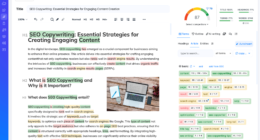Marketing management software combines essential tools for campaign planning, automation, analytics, and customer relationship management into one integrated platform. These solutions help teams track initiatives, optimize workflows, and measure ROI through real-time dashboards and data visualization. Key features include email automation, social media management, collaborative project tools, and extensive reporting capabilities. Modern systems prioritize user-friendly interfaces and secure data management, enabling marketing teams to achieve greater efficiency and strategic insights.
Quick Overview
- Marketing Manager Software centralizes campaign planning, automation, analytics, and CRM functionality in one comprehensive platform for streamlined operations.
- Essential features include real-time analytics dashboards, automated email campaigns, social media management, and customer interaction tracking.
- Integration capabilities with existing tools and systems ensure seamless data flow and reduced manual input across marketing operations.
- User-friendly interfaces with customizable dashboards allow teams to monitor KPIs, track ROI, and optimize marketing campaigns effectively.
- Robust security measures and data management protocols protect sensitive information while ensuring compliance with industry regulations.
Essential Components of Marketing Management Software

Modern marketing management software combines several essential components that work together seamlessly to streamline marketing operations.
The core elements include extensive campaign planning tools, advanced marketing automation features, robust analytics capabilities, integrated CRM functionality, and collaborative project management systems.
Campaign planning components allow teams to develop, track, and optimize marketing initiatives across multiple channels, while automation tools handle repetitive tasks like email campaigns and social media posting. The software’s comprehensive data management system processes information from multiple sources to enable informed marketing decisions. Popular platforms like marketing automation solutions such as HubSpot and ActiveCampaign offer comprehensive features for cross-channel campaign management.
The analytics suite provides real-time dashboards and data visualization for informed decision-making.
CRM features maintain centralized customer data and track all interactions, enabling better targeting and personalization.
Finally, collaboration tools facilitate team communication, resource management, and content approval workflows, ensuring smooth execution of marketing activities.
These components integrate to create a unified platform for effective marketing management.
Choosing the Right Software Stack for Your Marketing Team
When organizations commence on selecting marketing management software, a systematic evaluation process becomes essential for long-term success. The selection journey begins with a thorough assessment of current marketing needs, team capabilities, and specific business objectives.
Teams should focus on five key areas during evaluation: core functionality requirements, scalability potential, integration capabilities, vendor reliability, and hands-on testing. Creating a detailed capability map helps teams better understand their software needs and identify potential gaps in functionality.
The process starts by mapping existing workflows and identifying pain points that need addressing. Next, decision-makers must evaluate potential solutions based on essential features like CRM capabilities, automation tools, and analytics functions. Modern marketing automation platforms like HubSpot enable teams to streamline their workflow and enhance collaboration across departments.
Finally, organizations should conduct thorough testing of shortlisted options, considering factors such as user experience, customer support quality, and total cost of ownership before making their final selection.
Integrating Marketing Tools for Maximum Efficiency

Successful marketing teams recognize that integrating various marketing tools into a cohesive system represents a critical step toward operational excellence. By connecting different platforms through connector apps like Zapier or direct integrations, teams can create a seamless workflow that reduces manual tasks and improves efficiency. Marketing automation tools help deliver personalized campaigns at scale while maintaining quality. Lead scoring systems help businesses prioritize and nurture potential customers more effectively.
Integration isn’t just connecting tools – it’s building a unified system that drives marketing excellence and operational efficiency.
The benefits of integration are substantial. Marketing teams typically see a 30-40% reduction in data entry errors and a 15-20% increase in ROI through streamlined operations.
Integration enables:
- Real-time data sharing across platforms
- Consistent messaging across all channels
- Unified customer data management
- Automated campaign execution
- Extensive analytics tracking
While technical challenges exist, successful integration depends on careful planning, proper team training, and regular performance evaluation.
Organizations should focus on selecting tools that align with their business goals and guarantee scalability for future growth.
Measuring Success With Marketing Software Analytics
Marketing software analytics revolutionize how businesses track, measure, and optimize their digital marketing efforts. Through platforms like Google Analytics, HubSpot, and Semrush, companies can monitor essential KPIs and make data-driven decisions to improve their campaigns. The integration of creativity and data helps businesses achieve better engagement while maintaining analytical rigor.
These tools offer extensive insights through various analytical techniques:
- Real-time tracking of conversion rates and ROI
- A/B testing to optimize marketing content
- Predictive analytics for future campaign planning
- Attribution modeling to identify effective channels
- Sentiment analysis to understand customer feedback
Adobe Analytics solutions provide enterprise-level capabilities for comprehensive real-time data analysis. Success measurement becomes streamlined with customizable dashboards and automated reporting features. Marketing managers can easily compare results against industry benchmarks, track customer lifetime value, and analyze campaign performance across multiple touchpoints.
This data-driven approach guarantees continuous improvement and more efficient resource allocation in future marketing initiatives.
Best Practices for Marketing Software Implementation

To achieve ideal results with new marketing software, organizations must follow a structured implementation process that carefully considers planning, training, and execution. Successful implementation requires a thorough strategy that begins with clear goal setting and thorough needs assessment.
Key best practices include developing SMART objectives aligned with business goals, ensuring proper data management and integration with existing systems, and providing robust user training across multiple formats. Working with an email deliverability specialist is crucial for maintaining effective email communications and campaign success. Implementing multi-channel management capabilities allows businesses to maintain consistent messaging across various platforms.
Organizations should adopt a phased implementation approach, starting with pilot programs to test workflows before full deployment. Cross-functional collaboration between IT, marketing, and other departments is essential for smooth adoption.
Regular testing, feedback collection, and necessary adjustments help organizations optimize their marketing software implementation while maintaining data security and user engagement throughout the process.
Frequently Asked Questions
How Long Does It Typically Take to Train Staff on New Marketing Software?
Training staff on new marketing software typically takes 10-12 weeks for thorough mastery, though this timeline varies based on several factors.
Full-time intensive training can be completed in 6-8 weeks, while part-time programs may extend to 16-24 weeks.
The complexity of the software, prior experience of staff, and chosen training method (in-person, online, or hybrid) greatly influence the duration.
Most organizations successfully implement basic functionality within 4-6 weeks.
What Security Measures Protect Customer Data in Marketing Management Platforms?
Marketing management platforms employ multiple layers of security to protect customer data.
Key measures include encryption of data both in transit and at rest, role-based access control with multi-factor authentication, and regular security audits.
Platforms typically maintain GDPR and CCPA compliance, implement secure API integrations, and conduct vendor security assessments.
Additionally, thorough incident response plans and regular employee training guarantee ongoing data protection and quick response to potential threats.
Can Marketing Software Handle Multiple Languages and International Campaign Requirements?
Modern marketing software effectively handles multilingual and international campaigns through extensive features.
These platforms offer built-in support for 30+ languages, real-time translation capabilities, and localization tools for content adaptation. They manage multi-currency transactions, time zone scheduling, and region-specific compliance requirements like GDPR.
Advanced analytics track performance across different markets, providing insights on language-based engagement and regional metrics.
International campaign management includes local social media platform integration and cultural customization options.
What Happens to Historical Marketing Data When Switching Between Different Software Platforms?
When switching between marketing platforms, historical data typically faces several key challenges.
Data may need to be exported and reformatted to fit the new system’s requirements, with some information potentially being lost in translation.
Organizations often need to implement data warehousing solutions or use ETL tools to preserve their marketing history.
Cloud-based platforms generally offer better long-term accessibility, but thorough validation is essential to guarantee data integrity during migration.
How Often Should Marketing Software Tools Be Updated or Replaced?
With 72% of top Android apps updating monthly, marketing software should follow a similar frequent update schedule.
Best practices suggest reviewing marketing tools every 3-6 months for major updates, while enabling automatic smaller updates throughout.
Critical security patches should never wait, as 80% of data breaches are preventable through timely updates.
Companies should establish a regular update schedule that balances system stability with security needs and new feature implementations.
Conclusion
While implementing marketing management software requires significant upfront investment and training, the long-term benefits far outweigh these initial challenges. The right software stack streamlines workflows, provides actionable analytics, and helps teams achieve measurable results. By carefully selecting integrated tools, following implementation best practices, and consistently measuring performance metrics, marketing teams can transform their operations from reactive to proactive, driving better outcomes and ROI.









